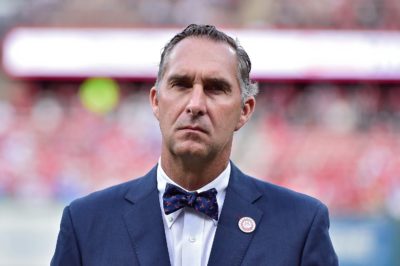The MLB Trade Deadline is coming soon. Only three more nights of sleep, and then it’s here. The dealing frenzy ends at 3 p.m. STL time on Friday afternoon.
This is kind of like a baseball Christmas. What marvelous gifts will the Santa-like general manager place around the pitcher’s mound and batter’s box to delight the fans?
Bah humbug.
Other baseball towns can look forward to their new toys. But around these parts the Cardinals have taken the fun out of the trade deadline.
The last jaw-dropping deal came in late July, 2014. The Cards offloaded Allen Craig’s bad contract on Boston, included young pitcher Joe Kelly in the shipment, and received starting pitcher John Lackey in return. Lackey was a habanero pepper in a bland and comfy clubhouse. He spiced things up, helped pitch the Cardinals into the 2014 NLCS, and was a valuable piece of a rotation that led the Cards to 100 wins in 2015.
The 2015 trade deadline provided some action. The incoming included lefthanded hitter Brandon Moss from Cleveland and relievers Steve Cishek (Miami) and Jonathan Broxton (Milwaukee.)
In 2016, Cards GM John Mozeliak limited his shopping to the acquisition of lefty reliever Zach Duke (White Sox.) Duke was effective while healthy, but elbow problems kept him out of the final series of the regular season. He underwent elbow surgery in October that year.
The 2017 deadline brought in a slugging prospect that’s finally paying off. The Cards acquired outfielder Tyler O’Neill from Seattle to lefty starter Marco Gonzales. Marco had slid down the St. Louis depth chart but successfully rebooted his career in Seattle.
In 2018 Mozeliak traded outfielder Tommy Pham to Tampa Bay for two prospects: LH reliever Genesis Cabrera and outfielder Justin Williams. The deal left fans boiling at the time but hasn’t been a total wipeout. Cabrera is an essential piece of the team’s current bullpen and it would be premature to write off WIlliams.
At the 2018 deadline Mozeliak sent Triple A first baseman Luke Voit to the NY Yankees for lefty relief specialist Chasen Shreve and righthanded reliever Giovanny Gallegos. Voit famously turned into a fearsome presence for the Bombers, averaging a homer every 15 at-bats and slugging .522 in his three-plus seasons with the Yanks. But his 2021 season has been interrupted by injuries.
Postscript: After the 2018 season the Cardinals traded for Arizona first baseman Paul Goldschmidt, and Gallegos has emerged as one of the better setup relievers in the majors. But Cardinals fans will never stop talking about Voit, the hometown boy who got away.
After 2014, the St. Louis trade deadlines have featured a whole lot of boredom, considerable disappointment, lingering bitterness over Voit and a couple of solid, helpful additions. (Gallegos and Cabrera.) And though O’Neill’s breakout required time and patience through several false starts, he’s evolved into the Cards’ best trade-deadline acquisition since Lackey in ‘14.
I reviewed these transactions in a loose attempt to set the level of expectations for Friday’s deadline. Easy translation: don’t expect much.
Do the Cardinals need a starting pitcher? YES. But the need was extreme and acute in June, and the front office declined to mitigate the crisis. And now that so much time has passed, Mozeliak can sit back and wait for starting pitchers Jack Flaherty and Miles Mikolas to complete their injury-rehab assignments and rejoin the STL rotation.
Do the Cardinals need a LH bat for the bench, someone that preferably can serve as a valuable fourth outfielder as insurance for potential injury to Harrison Bader and O’Neill? Of course. But that’s been obvious since last offseason, and the front office passed on signing a low-cost but effective depth piece. And the supply was plentiful.
Do the Cardinals need a proven major-league reliever that can ease the burden on Gallegos, Cabrera and Reyes? Yes. It would be nice to give the three some quality help instead of watching them burnout and crash. But the Cardinals have preferred the dumpster-dive method for bullpen improvement. Hey, such refurbishing projects work on those Discovery channel shows. Perhaps Mozeliak is a fan of furniture-rehab TV.

Aug 24, 2019; St. Louis, MO, USA; St. Louis Cardinals president of baseball operations John Mozeliak looks on during a ceremony prior to the start of a game against the Colorado Rockies during an MLB Players’ Weekend game at Busch Stadium. Mandatory Credit: Jeff Curry-USA TODAY Sports
The Cardinals were clearly in need of offense in 2015 and didn’t get it. Moss was OK in ‘15. That’s all; just OK. They were the best run-prevention team in the majors in ‘2015 but finished 24th in runs scored per game. The 100-win regular season blew up with a loss to the Cubs in the NLDS.
The 2016 Cardinals weren’t formidable, but they finished 10 games over .500 at 86-76. That team had no chance to win the division; the Cubs were a runaway train. But the ‘16 Cardinals were worthy of a wild-card playoff spot and came up short. The Giants and Mets each won 87 games, and got the wild-card tickets instead of 86-win St. Louis. Other than Duke the reliever — and he couldn’t pitch in the final three games of the season during desperation time — the Cardinals received no reinforcement via trade.
The 2017 Cardinals were only 3 games out of first place in mid-September but faded to an 83-79 record and failed to reach the playoffs. There were no roster upgrades at the deadline.
The 2018 Cardinals were tied for the most wins in the NL after Mike Shildt took over as manager in the game before the All-Star break. But other than making the move for Shreve — who was a flop — Mozeliak let his roster stand. (Gallegos and Cabrera weren’t deemed ready for the majors at that time.) The 2018 team won 88 games, marched to within 3.5 games of first place by the second week of September, but couldn’t close the gap.
The 2019 Cardinals surged to 91 wins and the division title, and pulled off an upset to beat Atlanta in the NLDS. But a suspect St. Louis offense — which finished below average in the NL that season in runs, slugging and OPS — batted .130 and scored only six runs in getting swept and humiliated by Washington in the NLCS.
Nothing came to St. Louis at the 2020 trade deadline.
And here we are again.
Here’s the question: if Mozeliak didn’t go big to invest in his pitching-rich, hitting-challenged team in 2015, or did nothing to help postseason contenders for three straight seasons (2016-18) and stood pat instead of boosting postseason-bound clubs in 2019 and 2020 …. well, why should we anticipate any meaningful action this time around?
Over the past five or six years the explanations haven’t changed. They’re all connected.
1–We just didn’t think the team was strong enough to justify giving up young talent, prospects, in trades.
2–Don’t want to mortgage the future.
3-Not willing to give up a top prospect for a rental player.
4–The price was too high — so many other teams were looking for pitching (or whatever) and we weren’t willing to give up top prospects in an overpay.
5–We made a thousand calls and exchanged a million texts but ultimately just couldn’t get anything done. But we really tried. It’s frustrating.
This year, at least so far, we’re hearing variations of all the above.
In other words: selections from Mo’s Greatest Hits.
Here’s what makes me chuckle a bit: isn’t it interesting how other MLB contenders rarely have to overpay and hand over their coveted prospects to obtain help? How does that work? How do other front offices manage to pull off difference-making trades at a reasonable cost?
Are we supposed to believe that trade partners are rigid in demanding two or three top prospects from the Cardinals — but yet are willing to settle for significantly less than when other contenders reach out to make a trade?
My friend Joe Sheehan, the baseball analyst, enlightened me on this topic a few weeks ago in his daily newsletter. I added italics for emphasis:
“There have been five top-50 prospects traded, total, during the last four seasons, and not a single one of them has been traded for a rental,” Joe wrote.
Also:
“Based on Baseball America’s 2016 preseason ranking, there were ten top-100 prospects traded during the ’16 season, including four top-50 prospects … It wasn’t unheard of for two rated prospects to be dealt in a single deal … And in separate deals, the Rangers traded three top-100 prospects.
“That kind of prospect trading still exists in the offseason, but it’s become very rare during the regular season. In 2017, eight top-100 prospects were dealt, but just one top-40 prospect…by 2018, these trades were disappearing. Just three top-100 prospects were dealt during the 2018 season, traded for players who were controlled (contractually) beyond 2018.
“In 2019, four top-100 prospects, just one in the top 60 was moved. Only one top-100 prospect was traded during the weird 2020 season. If you’re counting, it was ten in 2016, eight in 2017, and eight total in three seasons since.”
This belief — that a team must part with prospects from the overall MLB Top 100 list make an in-season trades … well, that just hasn’t been true for a while now. As Sheehan noted, teams have held onto their Top 100-caliber prospects (with very, very few exceptions) while making in-season trades since 2018. And teams have flat-out refused to exchange top prospects for rental help.
But the Cardinals keep pushing this largely bogus “We Won’t Mortgage The Future” narrative.
And here’s another thing: the front office likes to have it both ways. It goes something like this…
We had all of these unfortunate injuries … it really set us back … we lost a lot of ground in the standings … we have to be realistic about our chances … we have to be careful to protect our future … the damage caused by these injuries changed our outlook.
But here’s why the Cardinals were left so damaged and vulnerable by injuries: they did virtually nothing last offseason to smartly add depth and protect themselves from the impact of injuries. Insufficient depth was a contributing factor in the ensuing injury-related trauma. So you can’t cite injuries as an excuse to stay out of the trade market. You created much of this in the first place.
Personally, I have no desire to see the Cardinals part with top prospects in an effort to patch a couple of roster holes. They should have taken steps last winter to have patches in place. That’s how teams that are better than the Cardinals — the Brewers, Mets, Giants, Dodgers, Padres and Mets — have survived a larger number of injuries to keep on winning. Try to keep that in mind the next time the Cardinals go into their spin, and convince gullible media to repeat it. And I don’t need the Cardinals to make an ill-advised trade just to show me and others that they have the stomach to do it.
Something else must be asked: has Mozeliak lost confidence? Just because a few moves didn’t work out as intended, you can’t go into a shell. And just because a few deals caused various levels of anguish, you can’t just wait and hold out to make trades that are safe, and easy, and a guaranteed “win” for the Cardinals.
As Derrick Goold has correctly pointed out, Mozeliak is determined to go to the trade market with leverage — and use that leverage as a cudgel to dominate the trade partner. (See: Nolan Arenado.) That’s fine if you can get that done every time — but it’s also unrealistic to use that as a standard for making a trade. You can’t go into every potential deal with a 100 percent, risk-proof assurance. That’s ridiculous.
Where’s the GM who saved the 2011 season by flipping Colby Rasmus for vital rotation and bullpen help? Where’s the GM who improved the 2011 team for the stretch run by acquiring shortstop Rafael Furcal from the Dodgers?
I realize that this is a different time. There is no Tony La Russa to push and prod and challenge the front office in his quest for roster help. Mike Shildt just isn’t that type of manager.
Would it be nice to see Mozeliak get something done before the trade deadline to give Shildt and the players a push? Yes, even though Shildt and the coaches and the players are partially responsible for the team’s .500 record. Based on individual histories, some performances have been lacking. All due respect, players and pitchers should be doing better. The managers and coaches should be doing better.
The STL pitchers’ walks and hit-by-pitch sprees are inexcusable. Waiting until late June to make overdue adjustments in the team’s hitting approach is inexcusable. I really can’t believe there are media folks out there praising Shildt and the coaches for making an effort to sharpen the team’s two-strike hitting and nudge the batters to use all parts of the field. Seriously? They deserve credit for waiting half a season to correct serious flaws that should have been addressed much sooner? I’m sorry to be the grouch. Honest. But this stuff kinda drives me wacko.
If there’s no big deal this week, then here’s the real deal that must be confronted: get some starting pitching in the house, and I don’t care if you get it done now or by the start of next season. Get some muscle and depth for this lineup now, or by 2022. Even if the Cardinals make an unexpected run into the postseason, this season is still a set-up for 2022. They’re not close to a playoff spot right now. They have to make sure that this can’t happen again in 2022.
I’d be generally opposed to any move that slightly upgrades the Cardinals for now, for 2021, but weakens them for 2022. Perhaps there is a way to strengthen this team, as well as the 2022 team, but I’m skeptical. Or, perhaps more on point, I wonder if the cost of talent will be too high in the trade exchange rate. Especially for quality starting pitching — not so much a rental, but for a starter that has a contract through ’22.
But by 2022, the talented young hitters (Nolan Gorman and others) will be getting much closer to St. Louis. Top starting pitching prospect Mike Liberatore should be ready. There will be more payroll flexibility to work with. The post-pandemic financial outlook should be brighter. All the way around, the conditions will be more favorable for the Cardinals.
The time is coming for a more aggressive approach. Not just one splash move; but a splash followed by other impactful, ripple moves that don’t necessarily cost you a lot of money. You know, the way the Cardinals used to do it when they found big-payoff value in low-cost solutions.
It may not happen this week, but the time to make moves is coming. And when that right time comes, Mozeliak can’t play stall ball. The Cardinals have to let us know if they are in this to compete and be respectable — or in this to be bold and brash and win another World Series championship. If I have to wait for the answer, fine. But the time is coming.
A franchise with a $163 million payroll shouldn’t be chasing a team, the Brewers, with a $99 million payroll. And someone must answer for that.
Thanks for reading …
–Bernie
Check out Bernie’s sports-talk show on 590-AM The Fan, KFNS. It airs Monday through Thursday from 3-6 p.m. and Friday from 4-6 p.m. You can listen live online and download the Bernie Show podcast at 590thefan.com … the 590 app works great and is available in your preferred app store.
The weekly “Seeing Red” podcast with Bernie and Will Leitch is available at 590thefan.com …
Follow Bernie on Twitter @miklasz
* All stats used here are sourced from FanGraphs, Baseball Reference/Stathead, Bill James Online, Baseball Savant and Brooks Baseball Net unless otherwise noted.

For the last 36 years Bernie Miklasz has entertained, enlightened, and connected with generations of St. Louis sports fans.
While best known for his voice as the lead sports columnist at the Post-Dispatch for 26 years, Bernie has also written for The Athletic, Dallas Morning News and Baltimore News American. A 2023 inductee into the Missouri Sports Hall of Fame, Bernie has hosted radio shows in St. Louis, Dallas, Baltimore and Washington D.C.
Bernie, his wife Kirsten and their cats reside in the Skinker-DeBaliviere neighborhood of St. Louis.



